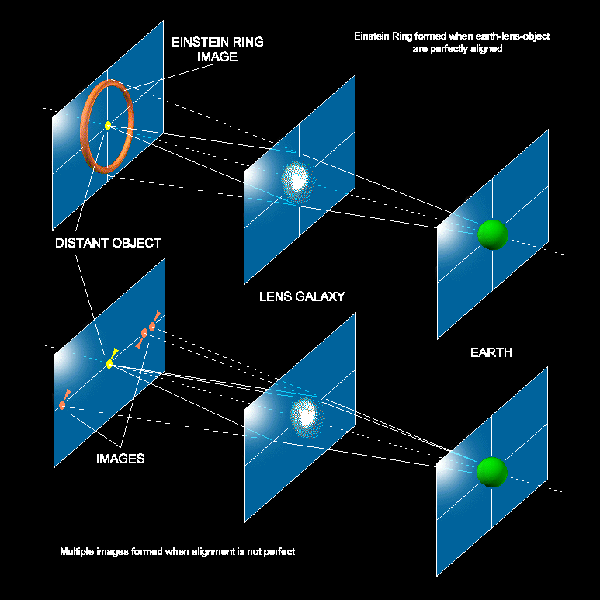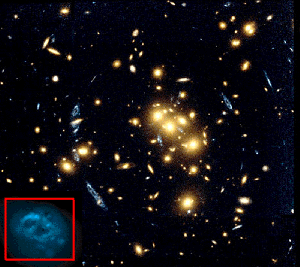8. GRAVITATIONAL LENSING:
We have already introduced this idea in Lesson
7, where we discussed the distortion of light around
a black hole, and in Lesson 8,
where we discussed the search for MACHOs. But the clearest evidence for gravitational
lensing comes from images of galaxies lying behind clusters of galaxies.
|

|
|
The principle of gravitational lensing. In the upper diagram, the
lens galaxy is perfectly aligned with a distant star-like object. The
gravity of the lens galaxy distorts the image of the distant object
into an Einstein Ring. In the lower diagram,
the lens galaxy is not perfectly aligned, so it distorts the image of
the distant object (a star with a jet) into multiple images. Source.
|
This actually happens:
|

|
|
(Upper) The Hubble Space Telescope image of the distant galaxy 1938+666
which has been imaged into an Einstein ring by an intervening galaxy.
The intervening galaxy shows up as the bright spot in the center of
the ring.
(Lower) The MERLIN radio picture of the radio source 1938+666 embedded
in the distant galaxy. The incomplete ring (or arc) shows that the radio
source is not perfectly aligned with the lens galaxy and the Earth.
The lens galaxy does not contain a radio source and hence does not show
up in this picture. The colors are computer-generated and represent
different levels of radio brightness. Source: A
Bull's Eye for Merlin and the Hubble
|
If the lensing object is not spherical, it can bend the light
in more complicated ways, forming multiple images of the background object.
Here's an example of an Einstein
Cross seen by the Hubble Space Telescope, in which the
background galaxy is broken into four images.
With the Hubble Space Telescope, astronomers have found several
examples of distant galaxies seen through the gravitational lens due to an intervening
cluster of galaxies. In that case, the bending of light due to the complicated
distribution of mass in the cluster can create several images of each galaxy.
The most spectacular example is shown below. (Click on the images to see larger
versions.)
|

|

|
|
Cluster CL0024 and multiple lensed images of background galaxy (inset
on lower left)
|
Mass
distribution of CL0024 (courtesy of Tony Tyson, Lucent Technologies)
|
In the image on the left, taken by the Hubble Space Telescope,
we see a cluster of reddish galaxies at a distance of about 5 billion light
years. We also see several arc-shaped images of blue galaxies. Five of them
are loop-shaped: they are all different images of the same galaxy! It is a ring
shaped galaxy lying behind the cluster, at a distance of about 10 billion light
years. Each image is distorted in a different way because the light rays have
been bent by the mass from different galaxies in the intervening cluster. The
inset in the lower left is a (magnified) mathematical reconstruction of what
the actual galaxy would look like without the distortions. (There are several
more blue images from other background galaxies.) The distortions of these multiple
images carry a tremendous amount of detailed information about the gravitational
fields -- hence the mass distribution -- in the intervening cluster of galaxies.
The image above on the right is a mathematical reconstruction of the mass distribution
in the cluster that is required to cause the observed multiple images. Observations
of lensed galaxies may be the most powerful method that astronomers have for
mapping the distribution of dark matter in clusters of galaxies.
If you have a high speed link, look at this fabulous movie
(10.2 Mbytes!), courtesy of Tony Tyson of Lucent Technologies. The red galaxies
are an HST picture of another cluster of galaxies called Abell 1689. The cluster
is seen moving to the right relative to the distant blue galaxies. Multiple
images of the blue galaxies form and disappear, just as in The
Real Einstein Ring.
Besides providing a method for measuring dark matter, gravitational
lenses have another big advantage: they can make astronomical objects appear
much brighter than they otherwise would be. For example, in July 1997, a press
release by the Space Telescope Science Institute announced the discovery of
the Farthest
galaxy in the Universe. This galaxy was discovered behind
a cluster of galaxies by the Hubble Space Telescope, and the 10-m Keck Telescope
in Hawaii found that it had a redshift of 4.92, making it the most distant object
seen in the universe at that time. That galaxy would have been too faint to
find but for the lensing action of the cluster.
But records are made to be broken, as you can check for yourself.
Astronomers are pushing the frontiers of the universe fast!
To understand the principle of gravitational lenses better,
to see how one can infer the masses of objects from observations of gravitational
lensing, and to find more great links to pages on gravitational lenses, see
Gravitational Lensing,
by Erin Reed and Michael Stroh.
(Return
to course home page)
Last modified March 30, 2002
Copyright by Richard McCray

